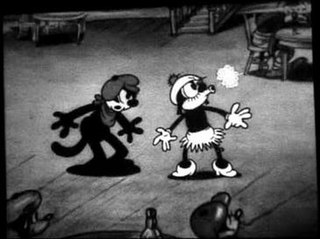Related Research Articles
Ratskin is a 1929 animated cartoon released by Columbia Pictures starring Krazy Kat. It is the first cartoon to be released by Columbia Pictures and the first Krazy Kat cartoon released with sound.
Seeing Stars is a 1932 short animated film distributed by Columbia Pictures, and features Krazy Kat. Different from most shorts of the series, the cartoon features celebrities in their animated forms.
Port Whines is a 1929 animated short film by the Columbia Pictures Corporation. It is the 136th Krazy Kat cartoon.

Sleepy Holler is a 1929 silent animated short film by Winkler Pictures, and stars Krazy Kat. It is the character's last silent film. It is also the last film of the series to be distributed by Paramount Pictures.

The Apache Kid is a 1930 cartoon short distributed by Columbia Pictures and features Krazy Kat. The film is the character's 149th film.
Love's Labor Lost is a 1920 short, animated film by Bray Productions and is one of the silent Krazy Kat cartoons. The film's title references a play by William Shakespeare.

Piano Mover is a 1932 short animated cartoon released by Columbia Pictures, starring Krazy Kat.
Birth of Jazz is a 1932 short animated film by Columbia Pictures, featuring Krazy Kat.
The Bandmaster is a 1930 short animated film distributed by Columbia Pictures, and one of the long-running cartoons featuring Krazy Kat. In a reissue print by Samba Pictures, the film is simply presented as Bandmaster.
The Peace Conference is a 1935 short animated film by Columbia Pictures, featuring the comic strip character Krazy Kat.

Slow Beau is a 1930 short animated film distributed by Columbia Pictures, starring Krazy Kat. The film also marks the debut of Krazy's second theme song which would have a much longer run than his first.
Southern Exposure is a 1934 short animated film distributed by Columbia Pictures. It is part of a long-running short film series starring Krazy Kat.
Bowery Daze is a 1934 short animated film distributed by Columbia Pictures. The film is one of the many animated adaptations featuring Krazy Kat who started out as a comic strip character.
The Katnips of 1940 is a 1934 short animated film distributed by Columbia Pictures, and stars Krazy Kat.
Disarmament Conference is a 1931 short animated film distributed by Columbia Pictures, and part of the long-running film series featuring Krazy Kat.
The Lone Mountie is a 1938 short animated film by Columbia Pictures, and part of the long-running Krazy Kat film series.
The Minstrel Show is a 1932 short animated film by Columbia Pictures starring the comic strip character Krazy Kat.
Railroad Rhythm is a 1937 short animated film by Columbia Pictures starring the comic strip character Krazy Kat, and part of a long-running series of short films featuring the character.
Stomach Trouble is a 1927 silent animated short starring the comic strip character Krazy Kat. The short was released by Winkler Pictures.
Hash House Blues, also spelled Hash-House Blues in some reissues, is a 1931 short animated from Columbia Pictures, and one of many in the long-running series of films featuring Krazy Kat.
References
- ↑ Lenburg, Jeff (1999). The Encyclopedia of Animated Cartoons. Checkmark Books. pp. 97–98. ISBN 0-8160-3831-7 . Retrieved 6 June 2020.
- 1 2 Sampson, Henry T. (1998). That's Enough, Folks: Black Images in Animated Cartoons, 1900-1960. Scarecrow Press. pp. 106–107. ISBN 978-0810832503.